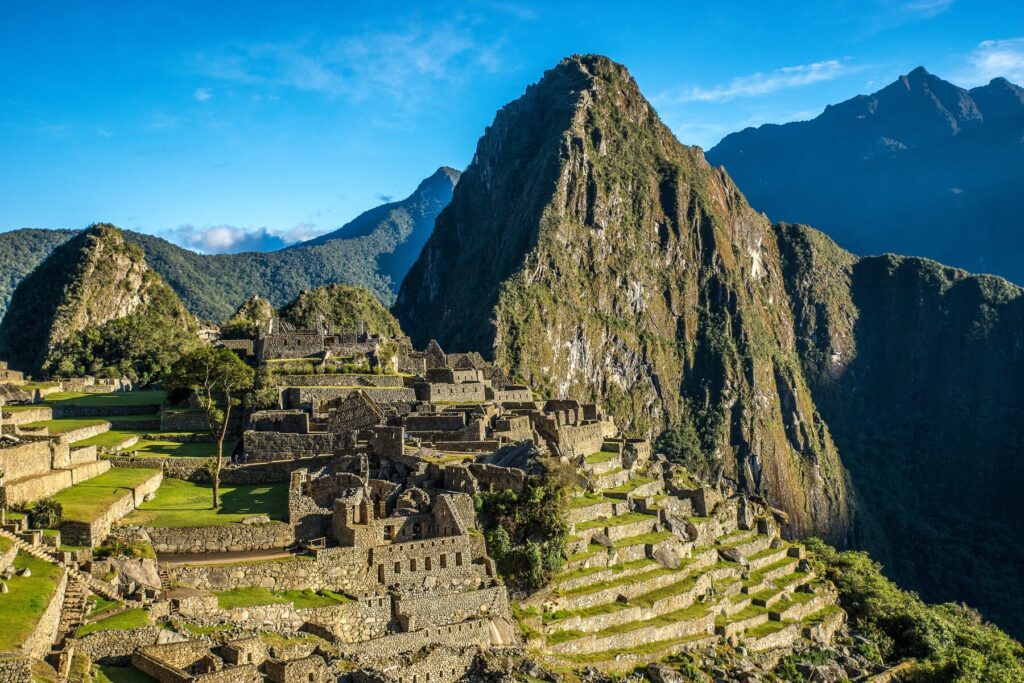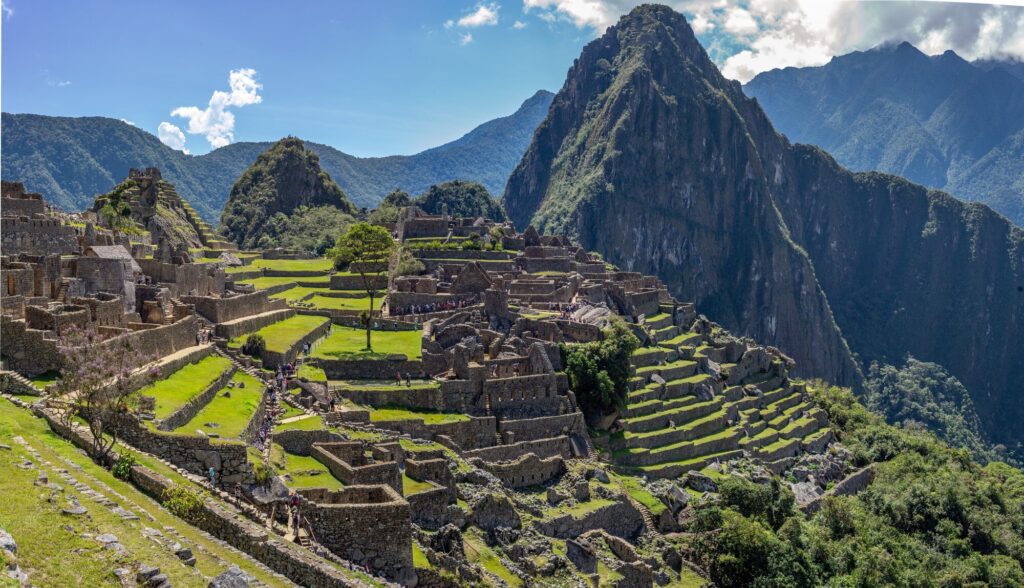Machu Picchu is an Inca citadel located in the Cusco Region of Peru, South America. It’s one of the most famous and mysterious sites in the world.

What does the name mean?
The name “Machu Picchu” comes from the Quechua language, which was spoken by the Incas. “Machu” means “old” or “ancient,” and “Picchu” means “peak” or “mountain.” So, the name Machu Picchu can be translated to “Old Mountain” or “Ancient Peak.”
What is the site?
Machu Picchu is a sprawling citadel built on a mountain ridge over 2,400 meters (7,900 feet) above sea level. The site covers an area of approximately 5 square kilometers (1.9 square miles) and features:
– Over 150 buildings, including temples, palaces, and dwellings – Intricately carved stone structures and pathways
– Agricultural terraces and irrigation systems
– A complex network of trails and roads
History and Significance
Machu Picchu was built in the 15th century by the Inca civilization, during the reign of Emperor Pachacuti. The site is believed to have been a sacred retreat for the Inca elite, a place of worship, and possibly even a royal estate.
Machu Picchu was abandoned before the arrival of the Spanish conquistadors and remained hidden for centuries. It was rediscovered in 1911 by American historian and explorer Hiram Bingham.
Today, Machu Picchu is a UNESCO World Heritage site, one of the Seven Wonders of the World, and a source of pride and inspiration for Peru and the world.
The creation of Machu Picchu is a fascinating story that involves the ingenuity, skill, and labor of the Inca people.

Planning and Design
The construction of Machu Picchu is believed to have begun in the 1450s, during the reign of Inca Emperor Pachacuti. The site was carefully chosen for its:
1. Strategic location: Machu Picchu is situated on a mountain ridge, providing a natural defensive position and control over the surrounding area.
2. Agricultural potential: The site has fertile soil and a favorable climate, making it suitable for farming and agriculture.
3. Spiritual significance: Machu Picchu is believed to have been a sacred site, aligned with the movements of the sun, moon, and stars.
Construction Process
The construction of Machu Picchu involved:
1. Planning and surveying: Inca engineers and architects planned and surveyed the site, taking into account the natural terrain and the intended use of each area.
2. Stone quarrying and transportation: The Incas quarried stone from nearby sites and transported it to Machu Picchu using ramps, pulleys, and levers.
3. Construction of buildings and terraces: The Incas built structures using stone, earth, and wood, with intricate carvings and stonework.
4. Agricultural terracing: The Incas built extensive agricultural terraces, which were used for farming and agriculture.

Engineering and Architectural Feats
The construction of Machu Picchu showcases the Incas’ impressive engineering and architectural skills, including:
1. Precise stonework: The Incas cut and fitted stones together with incredible precision, with some joints as small as 1/50th of an inch.
2. Drainage and irrigation systems: The Incas built sophisticated drainage and irrigation systems, which allowed them to farm the land and manage water resources.
3. Roads and trails: The Incas built an extensive network of roads and trails, which connected Machu Picchu to other Inca sites and allowed for the transportation of goods and people.
Labor Force
The construction of Machu Picchu required a massive labor force, which was comprised of:
Inca workers: Thousands of Inca workers, including skilled craftsmen, laborers, and engineers, worked on the construction of Machu Picchu.
Mit’a system: The Incas used the mit’a system, a form of labor taxation, to recruit workers from nearby villages and towns.
Timeline
The construction of Machu Picchu is believed to have taken place over several decades, with the following timeline:
1. 1450s: Construction begins during the reign of Inca Emperor Pachacuti.
2. 1460s-1470s: The site is developed and expanded, with the construction of buildings, terraces, and roads.
3. 1480s-1490s: The site is completed, and the Incas begin to use it as a royal estate and sacred retreat.
The creation of Machu Picchu is a testament to the ingenuity, skill, and determination of the Inca people.
Machu Picchu’s purpose is still a topic of debate among historians and archaeologists. However, based on various theories and evidence, here are some possible purposes:
1. Sacred Retreat: Machu Picchu might have served as a sacred retreat for the Inca elite, a place where they could connect with the gods, perform rituals, and seek spiritual guidance.
2. Royal Estate: Some researchers believe that Machu Picchu was a royal estate, built for the Inca emperor Pachacuti as a summer residence or a place to escape the hustle and bustle of Cusco.
3. Agricultural Center: The site’s extensive agricultural terraces and irrigation systems suggest that Machu Picchu might have been an important agricultural center, providing food for the local population and the Inca elite.
4. Astronomical Observatory: Some scientists propose that Machu Picchu’s architecture and alignments are connected to astronomical observations, such as the solstices, equinoxes, and planetary movements.
5. Pilgrimage Site: Machu Picchu might have been a pilgrimage site, attracting devotees from across the Inca Empire to worship, make offerings, and seek spiritual enlightenment.
6. Fortress or Military Outpost: A few researchers suggest that Machu Picchu served as a fortress or military outpost, protecting the Inca Empire from external threats and maintaining control over the surrounding region.
It’s likely that Machu Picchu served multiple purposes, reflecting the complex and multifaceted nature of Inca culture and society.

The Inca civilization abandoned Machu Picchu in the 16th century, and there are several theories as to why:
1. Spanish Conquest: The Spanish conquest of the Inca Empire in the 1530s led to the decline of the Inca civilization. The Spanish conquistadors, led by Francisco Pizarro, defeated the Inca emperor Atahualpa and took control of the empire.
2. Smallpox Epidemic: A smallpox epidemic swept through the Inca Empire in the 1520s, decimating the population and weakening the empire. This made it difficult for the Incas to maintain their control over Machu Picchu.
3. Civil War: The Inca Empire was plagued by civil war in the 1520s and 1530s, as different factions vied for control. This instability may have led to the abandonment of Machu Picchu.
4. Environmental Factors: Some researchers suggest that environmental factors, such as soil erosion, landslides, and climate change, may have made it difficult for the Incas to sustain themselves at Machu Picchu.
5. Shift to Cusco: The Inca capital was moved from Machu Picchu to Cusco in the 15th century, and it’s possible that the Incas simply shifted their focus and resources to the new capital.
It’s likely that a combination of these factors contributed to the abandonment of Machu Picchu.
Theories about the Abandonment :
Some researchers believe that the Incas gradually abandoned Machu Picchu over a period of time, as the population declined and the empire weakened. Others propose that the Incas suddenly abandoned Machu Picchu in response to a specific event, such as the Spanish conquest or a natural disaster.
Despite the uncertainty surrounding the abandonment of Machu Picchu, it’s clear that the site was left to the elements for centuries, until its rediscovery in the 20th century.
We’ve shared some lesser-known facts about Machu Pichu. Hopefully, you find them interesting and informative!
